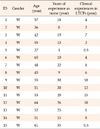1. Eriksen HM, Koch AM, Elstrom P, Nilsen RM, Harthug S, Aavitsland P. Healthcare-associated infection among residents of long-term care facilities: a cohort and nested case-control study. The Journal of Hospital Infection. 2007; 65(4):334–340. DOI:
10.1016/j.jhin.2006.11.011.

2. Hwang I, Kim H, Son Y, Jeong H, Kim M, Lee S, et al. Rate of antimicrobial resistant urinary pathogens and associated risk factor in older adults living in long-term care facilities in Seoul. Korean Journal of Family Practice. 2017; 7(6):864–869. DOI:
10.21215/kjfp.2017.7.6.864.

4. Yang M, Vleck K, Bellantoni M, Sood G. Telephone survey of infection-control and antibiotic stewardship practices in long-term care facilities in Maryland. Journal of the American Medical Directors Association. 2016; 17(6):491–494. DOI:
10.1016/j.jamda.2015.12.018.

5. Shah N, Castro-Sánchez E, Charani E, Drumright LN, Holmes AH. Towards changing healthcare workers' behaviour: a qualitative study exploring non-compliance through appraisals of infection prevention and control practices. The Journal of Hospital Infection. 2015; 90(2):126–134. DOI:
10.1016/j.jhin.2015.01.023.

6. Park YH, Bang HL, Kim GH, Oh S, Jung YI, Kim H. Current status and barriers to health care services for nursing home residents: perspectives of staffs in Korean nursing homes. Korean Journal of Adult Nursing. 2015; 27(4):418–427. DOI:
10.7475/kjan.2015.27.4.418.

7. Cole M. Qualitative research: a challenging paradigm for infection control. Br J Infect Control. 2006; 7(6):25–30.

8. Cohen CC, Pogorzelska-Maziarz M, Herzig CTA, Carter EJ, Bjarnadottir R, Semeraro P, et al. Infection prevention and control in nursing homes: a qualitative study of decision-making regarding isolation-based practices. BMJ Qual Saf. 2015; 24(10):630–636. DOI:
10.1136/bmjqs-2015-003952.

9. Travers J, Herzig CTA, Pogorzelska-Maziarz M, Carter E, Cohen CC, Semeraro PK, et al. Perceived barriers to infection prevention and control for nursing home certified nursing assistants: a qualitative study. Geriatric Nursing. 2015; 36(5):355–360. DOI:
10.1016/j.gerinurse.2015.05.001.

10. Ngam C, Hundt AS, Haun N, Carayon P, Stevens L, Safdar N. Barriers and facilitators to Clostridium difficile infection prevention: a nursing perspective. American Journal of Infection Control. 2017; 45(12):1363–1368. DOI:
10.1016/j.ajic.2017.07.009.

11. Seibert DJ, Speroni KG, Oh KM, DeVoe MC, Jacobsen KH. Preventing transmission of MRSA: a qualitative study of health care workers' attitudes and suggestions. American Journal of Infection Control. 2014; 42(4):405–411. DOI:
10.1016/j.ajic.2013.10.008.

12. Lee JS, Hwang R, Lim MK. A study on working conditions and factors related to job satisfaction of nurses in the long-term care facilities for the elderly. Journal of Korean Public Health Nursing. 2015; 29(3):551–564. DOI:
10.5932/JKPHN.2015.29.3.551.

13. Choi H. A concept mapping study of good service experience among the elderly residents of long-term care facilities. Korean Journal of Adult Nursing. 2016; 28(6):669–679. DOI:
10.7475/kjan.2016.28.6.669.

14. Hsieh HF, Sarah ES. Three approaches to qualitative content analysis. Qualitative Health Research. 2005; 15(9):1277–1288. DOI:
10.1177/1049732305276687.

15. Shenton AK. Strategies for ensuring trustworthiness in qualitative research projects. Educ Inf. 2004; 22(2):63–75. DOI:
10.3233/EFI-2004-22201.

16. Krein SL, Damschroder LJ, Kowalski CP, Forman J, Hofer TP, Saint S. The influence of organizational context on quality improvement and patient safety efforts in infection prevention: a multi-center qualitative study. Social Science & Medicine. 2010; 71(9):1692–1701. DOI:
10.1016/j.socscimed.2010.07.041.

17. Jump RL, Heath B, Crnich CJ, Moehring R, Schmader KE, Olds D, et al. Knowledge, beliefs, and confidence regarding infections and antimicrobial stewardship: a survey of Veterans Affairs providers who care for older adults. American Journal of Infection Control. 2015; 43(3):298–300. DOI:
10.1016/j.ajic.2014.11.017.

18. Trautner BW, Greene MT, Krein SL, Wald HL, Saint S, Rolle AJ, et al. Infection prevention and antimicrobial stewardship knowledge for selected infections among nursing home personnel. Infection Control & Hospital Epidemiology. 2017; 38(1):83–88. DOI:
10.1017/ice.2016.228.

19. Saint S, Kowalski CP, Banaszak-Holl J, Forman J, Damschroder L, Krein SL. The importance of leadership in preventing healthcare-associated infection: results of a multisite qualitative study. Infection Control & Hospital Epidemiology. 2010; 31(9):901–907. DOI:
10.1086/655459.

20. Spires SS, Talbot HK, Pope CA, Talbot TR. Paramyxovirus outbreak in a long-term care facility: the challenges of implementing infection control practices in a congregate setting. Infection Control & Hospital Epidemiology. 2017; 38(4):399–404. DOI:
10.1017/ice.2016.316.

21. Kim HJ, Kim HY. Emotional labor, job stress and professional quality of life among nurses in long-term care hospital. Korean Journal of Adult Nursing. 2017; 29(3):290–301. DOI:
10.7475/kjan.2017.29.3.290.

22. Alexander GL, Rantz M, Galambos C, Vogelsmeier A, Flesner M, Popejoy L, et al. Preparing nursing homes for the future of health information exchange. Applied Clinical Informatics. 2015; 6(2):248–266. DOI:
10.4338/ACI-2014-12-RA-0113.
23. Smith PW, Bennett G, Bradley S, Drinka P, Lautenbach E, Marx J, et al. Shea/Apic guideline: infection prevention and control in the long-term care facility. Infection Control & Hospital Epidemiology. 2008; 29(9):785–814. DOI:
10.1086/592416.

24. Park EJ, Lim YJ, Cho BH, Sin IJ, Kim SO. A survey on performance of infection control by workers in nursing homes for the elderly. Journal of Korean Gerontological Nursing. 2011; 13(2):79–90.
25. Kim HJ, Kim HY. Experience of job stress among nurses working in long-term care hospital: a phenomenological approach. Korean Journal of Adult Nursing. 2016; 28(5):572–584. DOI:
10.7475/kjan.2016.28.5.572.

26. Park YH, Lee SH, Lee YM, Lee CY, Lee MH. Development of evidence-based guidelines for nursing home's infection control in Korea. J Muscle Joint Health. 2018; 25(2):135–147. DOI:
10.5953/JMJH.2018.25.2.135.
27. Kreman T, Hu J, Pottinger J, Herwaldt LA. Survey of long-term-care facilities in Iowa for policies and practices regarding residents with methicillin-resistant staphylococcus aureus or vancomycin-resistant enterococci. Infection Control & Hospital Epidemiology. 2005; 26(10):811–815. DOI:
10.1086/502498.

28. Choi HW. An analysis of the current conditions of the patient rooms of the long-term care facilities in Seoul city. Asia-pacific Journal of Multimedia Services Convergent with Art, Humanities, and Sociology. 2017; 7(8):751–762. DOI:
10.14257/ajmahs.2017.08.18.

29. Centers for Disease Control and Prevention. Tracking infections in long-term care facilities [Internet]. USA: Centers for Disease Control and Prevention;2012. cited 2018 September 28. Available from:
https://www.cdc.gov/nhsn/ltc/index.html.
30. Herzig CTA, Dick AW, Sorbero M, Pogorzelska-Maziarz M, Cohen CC, Larson EL, et al. Infection trends in US nursing homes, 2006–2013. J Am Med Dir Assoc. 2017; 18(7):635.e9–635.e20. DOI:
10.1016/j.jamda.2017.04.003.

31. Alexander GL, Madsen RW. A report of information technology and health deficiencies in US nursing homes. J Patient Saf. 2017; DOI:
10.1097/PTS.0000000000000390.









 PDF
PDF ePub
ePub Citation
Citation Print
Print






 XML Download
XML Download